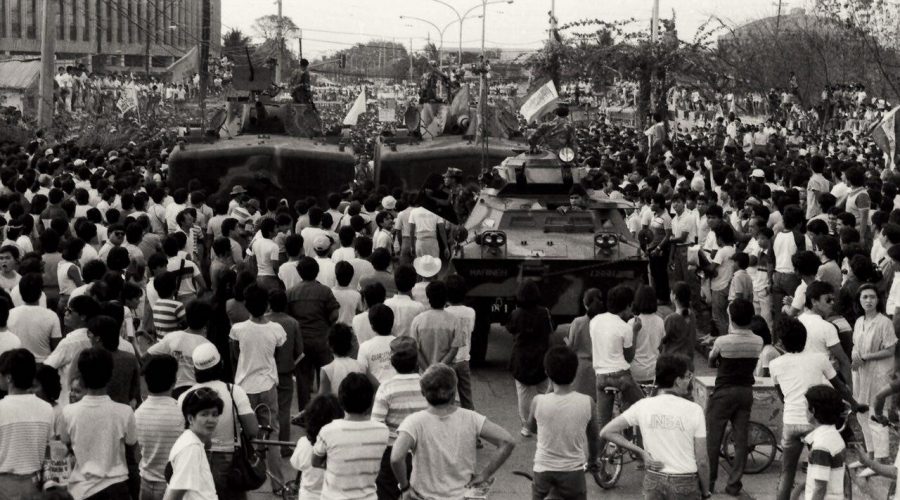People Power
People Power Is In Our DNA
Bumper to bumper traffic, honking buses, the scent of exhaust, startling potholes, and the allure of bright billboards… This is the EDSA we experience today.
30 years ago though, EDSA meant something more. EDSA, especially to my generation, meant courage in the face of fear and oppression, unity for a greater good, and the willingness to sacrifice for your fellow Filipinos.
EDSA meant People Power. But now, some of our countrymen say that People Power is dead.
These Filipinos proclaim that the EDSA Revolution is just a ghost, whose remains have long been buried and its essence wasted.
But these Pinoys who have lost faith are mistaken. EDSA cannot die; People Power is in our DNA.
Haven’t we all come across the iconic depiction of men and women lifting their neighbor’s kubo on their shoulders, selflessly bringing the house to safety?
During times of crisis, when a super-typhoon, massive flood, or earthquake hits our country, don’t we rush to a volunteer center with donations and a strong desire to reach out to those affected?
Do we not find joy and fulfillment in building homes for poor Filipino communities, carrying blocks of cement and painting walls with bright, happy colors along with friends from Gawad Kalinga and Habitat for Humanity?
These are all manifestations of the bayanihan spirit that is woven into our cultural fabric.
Around the country, we find strangers united in noble missions that extend beyond family ties, tapping a shared humanity and nationalism.
In the world of social enterprise, I have seen firsthand how social entrepreneurs, government agencies, corporations, microfinance institutions, cooperatives, and NGOs come together to find solutions to lift our countrymen out of poverty through business.
These mini-movements transformed the lives of the farmers turned agri-preneurs in Nueva Ecija, who now supply to Jollibee, the urban artisans of Rags2Riches, and Hapinoy’s successful sari-sari store owners.
In the youth sector, we see organizations made up of eager young Filipinos seeking to uphold noble values and uplift marginalized sectors.
Every year since 2002, we would award the Ten Accomplished Youth Organizations (TAYO Awards) and, just this year, we met the SOLACE organization that protect the rights of forgotten Filipino detainees in Mandaue City as well as the Kanlaon Theater Guild from Bacolod that educates communities on disasters through their talent, creativity, and volition – just two of thousands of youth organizations that have joined the TAYO search.
Finally, when the legislature was rocked by the Napoles-PDAF scandal two years ago, we still saw thousands upon thousands of our countrymen congregate to decry the corruption and push for reforms in an overly abused system.
The commonality is, much like in the EDSA Revolution, these people took matters in their own hands and took a collective stand, not against a dictator, but against violence, poverty, corruption, and suffering.
These are modern-day examples of the EDSA spirit, the bayanihan instinct, and People Power.
Call it what you will, these revolutions, however sizable or small, are alive and thriving in the Philippines. And to deny that this exists is simply misleading and fraudulent.
Much has changed over the last 30 years. From being one of the poorest countries in the 80s, we are the fastest growing economy in the ASEAN.
Then considered one of the most corrupt countries in the world, we have pushed for justice against the most powerful in all of the three branches of government.
People Power has also evolved from being centralized and primarily focused on political reform to one that includes a social and economic agenda and is dispersed throughout our country.
Historically, People Power was the well we drew upon when things took a turn for the worst; when corruption was at its highest, the rule of law least respected, our human rights and freedoms abused and trampled upon by the few for their own gain and benefit.
The challenge today is to evoke this revolutionary spirit not only in times of crisis, but in moments of opportunity as well.
The challenge is to never forget that there is greatness in us. And that if we stand together, much like 30 years ago at EDSA, even the most insurmountable can be overcome.
First Published on Manila Bulletin
BIDA KA!: Ang bagong People Power
Taos-puso akong nagpapasalamat sa pamunuan ng Abante sa pagbibigay-daan na mailathala ang aking mga opinyon at pananaw sa mga mahalagang isyu ng ating bayan.
Nagpapasalamat din ako kina Fitzgerald Cecilio at Nicco Atos na kasama ko linggu-linggo sa pagtatalakay ng mga isyu at paksa para sa kolum na ito.
Higit sa lahat, nagpapasalamat ako sa inyo, mga Bida, sa inyong pag-aabang at pagsubaybay sa ating kolum sa nakalipas na isang taon.
Sana’y ipagpatuloy ninyo ang walang sawang pagtangkilik sa ating kolum sa mga susunod pang taon, dahil dito, kayo ang Bida!
***
Isa pang patunay na napakabilis ng panahon ay ang katatapos na pagdiriwang ng ika-29 na anibersaryo ng EDSA People Power revolution.
Halos tatlong dekada mula nang ito’y mangyari ngunit buhay na buhay pa rin ito sa aking alaala.
Siyam na taong gulang lang ako nang mangyari ang tinaguriang “bloodless revolution” ngunit hanggang ngayon, damang-dama ko pa ang nagkakaisang pagkilos ng dalawang milyong Pilipino para mapatalsik ang diktadurya.
Tandang-tanda ko pa pati ang pagkain ng ice buko at pakikipagsalu-salo sa pagkain kasama ang iba pang mga nagra-rally sa apat na araw naming pamamalagi sa kanto ng Annapolis at EDSA.
Hindi natin namalayan na dalawampu’t siyam na taon na pala ang nakalipas mula nang mangyari ang People Power. Malayung-malayo na tayo ngayon sa dekada otsenta.
Ang postcard ay napalitan na ng photo at video messaging at karaniwan na lang ang cellular phone. Ang pagsali sa mga rally ay napalitan na ng pagpirma sa online petitions at madalas na tayong naglalagay ng hashtags (#) kung may isinusulong na kapakanan o adbokasiya.
***
Kasabay ng mga pagbabagong ito, nag-iba na rin ang paraan ng pagpapahayag sa People Power. Ito’y dahil nakakita ang mga Pilipino ng iba’t ibang paraan para magsama-samang tumulong na itayo at palakasin ang ating bansa.
Naaalala ninyo pa ba ang matinding pagbaha nang tumama ang bagyong Ondoy sa Mega Manila? O di kaya ang mas sariwang lungkot na naranasan ng Pilipinas noong tumama ang bagyong Yolanda sa Eastern Visayas?
Sa mga nasabing delubyo, maraming nawalan ng tahanan at kagamitan. Maraming nawalan ng bahay at buhay.
Subalit kakaibang People Power ang ipinakita ng taumbayan para agad makapaghatid ng tulong. Napuno ng donasyon at umapaw sa volunteers ang mga unibersidad, mga basketball court at iba’t ibang mga headquarters.
Ngayon, tuwing may lindol, bagyo, storm surge o anumang trahedya, lumalabas ang diwa ng bayanihan ng bawat isa.
Sa programa nitong Milk Matters, layon ng Phi Lambda Delta Sorority na tiyakin ang ligtas at tuluy-tuloy na supply ng breastmilk para sa high-risk neonates of the UP-Philippine General Hospital Neonatal Intensive Care Unit (PGH-NICU).
Hangad din ng grupo na hikayatin ang mga nanay na gumamit ng breastmilk para sa kanilang sanggol at pagtatatag ng community-based milk banks sa local government units.
Maituturing din na People Power ang pagsusulong ng Kanlungan Pilipinas Movement Inc. ng Balay Kanlungan ng Karunungan, isang nipa hut na naglalaman ng Android-based mini personal computer na may e-books, educational games at videos, and a 16-inch light-emitting diode o LED television – na pawang pinatatakbo ng solar power system.
Layon nito na magbigay ng impormasyon at learning sa malalayong komunidad sa pamamagitan ng paglalagay ng E-Learning Centers kung saan maaaring bumisita at makakuha ng educational materials ng libre.
Sinolusyunan naman ng Katipunan ng mga Kabataang Santiagueño ang lumalalang problema sa basura ng Santiago City sa Isabela sa pamamagitan ng paggawa ng bio-organic fertilizer.
Isa sa mga proyekto ng grupo ay ang paggawa ng charcoal briquettes mula sa dahon, sanga at iba pang basura mula sa halaman na kanila ring ibinebenta para makadagdag sa pondo.
Ang huling tatlong youth groups na ito ay mga nanalo sa Ten Accomplished Youth Organization Awards ngayong taon. Nasa ikalabindalawang taon, nais ng TAYO Awards na kilalanin ang mga kabataang gumagawa ng makabuluhang mga proyekto’t programa sa kanilang mga komunidad.
Ito na ang bagong mukha ng People Power – nagkakapit-bisig ang iba’t ibang sektor ng lipunan para makatulong sa kapwa at bumuo ng mas matibay at maunlad na bansa.
Hanggang may mga Pilipinong nagsasama-sama upang isulong ang kapakanan ng mga komunidad sa Pilipinas, mananatiling buhay ang diwa ng People Power sa bawat isa sa atin!
First Published on Abante Online


Recent Comments